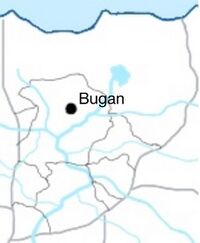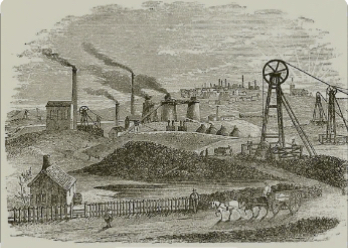Bugan (city)
This article is incomplete because it is pending further input from participants, or it is a work-in-progress by one author. Please comment on this article's talk page to share your input, comments and questions. Note: To contribute to this article, you may need to seek help from the author(s) of this page. |
Bugan
Bugan Orden (Kjerso) | |
|---|---|
City | |
Bugan´s skyline. | |
 Bugan´s location in the state. | |
| Country | Yogania |
| Region | Kjerso |
| State | Bugan (state) |
| Founded | c. 700 |
| Government | |
| • Type | Mayor–council government |
| • Mayor | Jom Bulagen (JDS) |
| Area | |
| • Total | 12,992 km2 (5,016 sq mi) |
| • Land | 11,846 km2 (4,574 sq mi) |
| • Water | 1,146 km2 (442 sq mi) |
| Population (2022) | |
| • Total | 20,346,511 |
| • Density | 1,600/km2 (4,100/sq mi) |
| 3rd in Yogania | |
| Demonym | Buganol |
| Time zone | UTC+3 |
| Area code | 90 |
| Website | www.buganorden.yo |
Bugan, officially the City of Bugan (Kjerso: Bugan Orden) is a city located in the region of Kjerso, Yogania. It´s the capital of the state of Bugan and is the largest city in Kjerso and 3rd largest city in Yogania by population after Yocopo and Burnach with 20 million inhabitants. It is built near the Buganheulen River. It is known internationally for being the northernmost big city in the world, being only 700 kilometers away from the North Pole. Bugan is one of the three most important cities in Yogania, it houses the headquarters of Hanggalt Bank and the HGTV television channel, two very important companies in Yogania. The city is known for it's skyscrapers and modern architecture, it has the tallest skyscraper in Europe, the HGTV building standing at 609 meters. It is also known for having one of the most developed public transport systems in the country.
Etymology
The name Bugan comes from the Buganollien Mountains, a chain of mountains located 100 kilometers to the north of the country. The word "Buganollien" comes from the Ancient Kjerso language and roughly means "Lakeside Mountains"
History
First Human Settlements
Archeological evidence shows that the area around Bugan has been inhabited since at least the 2nd millenia B.C. The first mention of Bugan was in an ancient Kjerso text from 860 A.D describing it as a "mid-size town".
Kingdom of Kjerso
By 970 A.D, Bugan was one of, if not the biggest city in Kjerso. It was made the capital of the kingdom in 1020 because of it´s strategic position at the very north of the country. During the Conquering of Kjerso, military general Yalashi Bogelnod moved his armies to Bugan as it was the last big city remaining unconquered.
Middle Ages
After the Conquering of Kjerso, Bugan remained mostly intact, Burydan Halfdan wanting to preserve Kjerso language and culture. Bugan´s inhabitants were mostly peasant farmers living far away from the center of the city, where the nobles lived. They lived mostly from hunting and agriculture. At that time, Bugan was mostly known for it´s market, Yoganian documents from that era mention people traveling from nearby cities just to visit this market.
19th Century
Bugan´s population experienced a rapid increase in the 19th century, going from approximately 5 million to 11 million between 1833 and 1898 due to Bugan and it´s surrounding area being rich in coal reserves, several coal mines and factories popped up in the area, attracting farmers who had recently lost their jobs to work as coal miners. Coal industry workers started to move to the city, to a point where there were not enough houses for all the workers and their families to live in, so they resorted to living in basements and storage rooms, with horrible living conditions. The Yoganian Housing and Worker´s Rights act of 1909 introduced laws intended to fix these problems.
Geography and Climate
Physical Geography
Bugan lies on the Buganheulen River, itself coming from the Buganol Lake. It is built on the riverbed, making the city relatively flat with occasional hills. It is located in the northeast of Yogania.
Administrative Geography
Bugan is the capital and largest city of the state of the same name and the unofficial capital of Kjerso. Bugan is located near several other big cities, including Salgon (11 million inhabitants), Gungarne (3 million inhabitants), and Perske (220,000 inhabitants).
Climate
See also: Köppen Climate Classification
Bugan has been called the world's coldest big city, experiencing an extremely cold subarctic climate, which means it often reaches to below -30°C and sometimes to -60°C in the coldest months. Winter in Bugan lasts from October to beginning of May. Summer is very mild, rarely going over 18°C and only lasting from June to mid August. Bugan frequently experiences snowstorms in winter.
City Divisions
Bugan is divided into 8 Bolgeds (districts), the biggest of them being Bugan Yodorin ("Bugan Center"), the city´s downtown area, which is the center for business, world trade, entertainment and tourism in the city. All 8 Bolgeds have their own administrative government, supervised by the city´s government.
Demographics
Population
Bugan is the largest city in Kjerso and the third largest city in Yogania with an estimated population of 20,346,511 million inhabitants (YSI).

